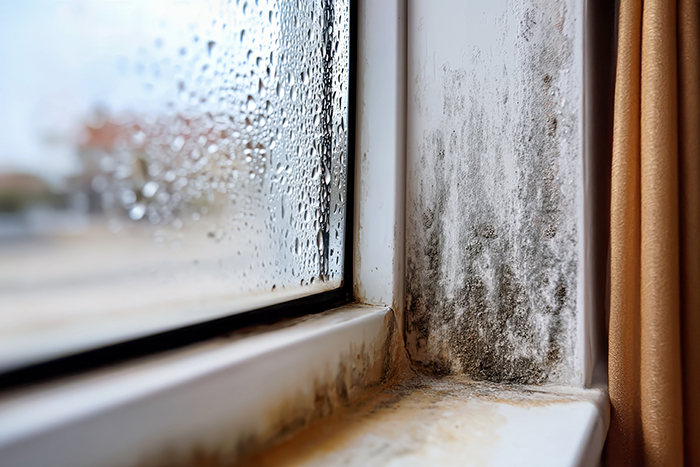How to detect and avoid hidden defects in houses
Becoming a homeowner is an exciting time! However, it is normal to have some reservations, especially when it comes to hidden defects. Fortunately, there are ways to reduce risk and buy with confidence.

Do you really know what constitutes a hidden defect? How can you prove it? How long do you have to take action against a seller? To avoid any unpleasant surprises, it is important to understand what a hidden defect is, what to look out for and which professionals you need on your side. Armed with this knowledge, you can make your next real estate transaction a well-informed one!
What is a hidden defect?
According to Article 1726 of the Civil Code of Québec : “The seller is bound to warrant the buyer that the property and its accessories are, at the time of the sale, free of latent defects which render it unfit for the use for which it was intended or which so diminish its usefulness that the buyer would not have bought it or paid so high a price if he had been aware of them.”
A hidden defect is therefore not just an aesthetic defect. It is a serious and important defect, which exists at the time of purchase, but which is neither apparent nor detectable by a prudent and diligent buyer during a simple inspection.
The 4 key criteria of a hidden defect
There are four criteria to be met cumulatively for a problem to be considered a hidden defect. The problem must:
1. Be serious
The problem must render the home unfit for use or significantly reduce its usefulness. It must be serious enough that, if you had known about the defect, you would not have bought the house or you would have bought it for a lower price.
2. Be hidden
The defect must not be detectable during a careful visual inspection by a prudent buyer. In other words, the pre-purchase inspection carried out by a building expert revealed no evidence of this problem. This criterion is assessed on a case-by-case basis, depending on the circumstances. You have to ask: in the same circumstances, would a prudent and diligent buyer have noticed the defect, or would they have seen something that could lead to its discovery without the help of an expert?
3. Exist at the time of sale
To take action against the seller, you must prove that the defect already existed at the time of the sale, even if it was unknown or invisible at that time.
4. Unknown to the buyer
A defect cannot be considered hidden if the buyer knows about it at the time of sale. The seller has an obligation to disclose all known information about the property in the Declarations by the Seller form, including any defects and potentially damaging issues.
|
Tips and tricks According to the Association des consommateurs pour la qualité dans la construction (ACQC) , a hidden defect does not necessarily mean that the house is uninhabitable. For example, a crack in the foundation causing significant water infiltration may be considered a hidden defect if it wasn’t detected during the pre-purchase inspection. |
The difference between a hidden defect and an apparent defect
According to the Office québécois de la langue française (OQLF) , an apparent defect is a [Translation] “defect in a property, which can be detected during an inspection without requiring the services of an expert, and which is unknown to its owner.” Unlike hidden defects, apparent defects can be identified by a prudent and diligent buyer without the need for an expert.
If a problem is mentioned in the Declarations by the Seller form or the pre-purchase inspection report, it cannot be deemed a hidden defect. In case of doubt, it is up to the buyer to investigate further by asking questions or requesting additional expertise to reveal the possible existence of a defect before purchase.
However, an apparent defect may be considered a hidden defect if the seller has exerted pressure to mislead the buyer or prevent them from properly inspecting the property. In other words, the seller cannot conceal a problem, omit essential information or reassure you with false information to encourage you to buy the property. Under such circumstances, a defect will legally qualify as hidden.
|
Tips and tricks A defect caused by normal wear and tear or use is not considered a hidden defect, even if it is significant. To avoid any unpleasant surprises, find out about the useful life expectancy of the property’s components. |
Most common hidden defects
Here are 5 common hidden defects in buildings:
1. Water infiltration
Water infiltration is often caused by a waterproofing problem in the house , poor surface water flow, or non-compliant landscaping. If leaks are not fixed quickly, they can result in considerable property damage. In addition, an environment conducive to the proliferation of several types of mould can affect indoor air quality and weaken the structure of the house.
2. Excessive moisture causing mould
High moisture levels, particularly in basements, walls and ceilings, may be due to faulty or aging insulation or poor attic ventilation. This can lead to mould growth on plaster, wood and other organic materials in the house. The presence of efflorescence, a whitish deposit at the bottom of walls, is also a sign of a possible moisture problem.
3. Non-compliant electrical and circuit panel
An outdated electrical panel, improper wiring, or faulty sockets can compromise safety. Certain smaller panels no longer meet current requirements and must be replaced to maintain a safe electrical system.
4. Wood rot in the attic
A damaged roof or poor insulation can lead to water infiltration and moisture problems in the attic. Insufficient ventilation can also cause condensation and accelerate wood degradation, which may require decontamination to prevent the spread of mould. These hidden defects are usually due to a construction defect or lack of maintenance.
5. Structural damage
Cracks in the foundations can lead to water infiltration that weaken the structure of the house. They may be caused by a construction defect, freezing and thawing, ground subsidence, or the presence of pyrite in the backfill . Poor load management, including the removal of a load-bearing wall or the addition of a floor, can also compromise the stability of the building. If signs of deterioration appear, such as cracked walls or collapsed floors, you should consult an expert and look into the reputation of the contractor who carried out the work .
How to spot a hidden defect
The best way to identify a hidden defect is to have a pre-purchase inspection carried out by a certified building inspector. While not mandatory , it is highly recommended as it could work in your favour if problems are discovered post-transaction.
When visiting a property, pay attention to the condition of walls and ceilings, look for cracks and signs of moisture, see whether doors and windows open properly, and ask questions to ascertain whether electrical panel and foundations are compliant.
When carrying out a thorough visual inspection (pre-purchase inspection), a good building inspector will assess certain key elements, such as the roof, plumbing and ventilation, for possible problems. Some visual clues, such as black spots, persistent odour or abnormal cracks, may warrant additional examinations and assessments, such as a pyrite or mould test.
|
Tips and tricks Before hiring a building inspector, make sure they have liability insurance. In the event of error, negligence or omission on their part, liability insurance could cover damages from defects that should have been identified during the pre-purchase inspection. |
Buyer: what to do if a hidden defect is discovered post-purchase
Even taking every precaution before buying cannot guarantee against defects being discovered after taking ownership. Some of them may even appear several years later and be considered as hidden defects.
What is a legal warranty?
The legal warranty of quality —also known as the warranty against hidden defects—protects buyers in the event of hidden defects affecting a home or its associated elements, such as a swimming pool, fireplace, porch or garage.
This clause automatically applies to all transactions, unless it is a sale without legal warranty or a property sold under court decree. In this case, the buyer agrees to take possession of the property in its current condition, which limits their recourse if they discover a hidden defect.
A legal warranty has limitations . It does not cover apparent defects, including problems reported in the Declarations by the Seller form or those that could have been detected by a pre-purchase inspection, an up-to-date certificate of location, or a search in the land register carried out by a notary.
3 steps to obtain recourse for hidden defects
To establish proof of a hidden defect, you need to demonstrate the four (4) criteria mentioned above to prove that the problem existed before the purchase and that the defect was not visible at the time of the transaction, and provide a report attesting to the severity and impact of the defect. These three steps will help you when seeking recourse:
1. Document the defect
Take photos and videos of the problem. Get advice from an expert in the domain, such as an architect, engineer, electrician or specialist in decontamination, to assess the situation and estimate the cost of the required repairs.
2. Send a notice of defect to the seller
Send a notice of defect to the seller within a reasonable period of time, usually within six months of discovering the defect. This official document informs the seller of the defect and gives them a chance to detect and correct it before you take legal action. Do not do any work until you have a response from the seller, otherwise you may compromise your right to recourse.
3. Assess whether you want to initiate legal proceedings
If the seller refuses to take responsibility, you can take the case to court, ideally with a lawyer. Relief of less than $15,000 falls under the jurisdiction of the Small Claims Division , while a dispute for an amount between $15,000 and $74,999.99 is dealt with exclusively by the Court of Québec. Amounts between $75,000 and $99,999.99 fall within the jurisdiction of both the Court of Québec and the Superior Court (the plaintiff can choose), while the Superior Court has exclusive jurisdiction for amounts exceeding $100,000.
There are several options available when seeking legal recourse:
- Request cancellation of the sale in the event of a major problem.
- Demand a reduction in the sale price as compensation.
- Claim reimbursement of damages, if it is proven that the seller knew or could not have been unaware of the defect(s).
Time limit for filing an application in Quebec
You must comply with the applicable time limit (prescription) for the nature of the complaint. You have three years from the discovery of the defect to file an application for a hidden defect with the judicial authorities.
However, be sure to inform the seller as soon as possible to give them an opportunity to fix the problem. The starting point of the time limit can be the date on which you discover the defect or the date on which you become aware of its severity.
Prudence: the key to successful property purchase
From the signing of the brokerage contract to the signing of the deed of sale, your real estate broker can guide and inform you as well as pick up on anything that could compromise the transaction. However, the role of a broker has limitations: they cannot give you a legal opinion, draft a formal notice for hidden defects, or act in place of a building expert to assess any work.
As an owner, preventive maintenance is your best way of preventing a minor problem from becoming a hidden defect. A neglected roof, water infiltration or cracked foundation can, over time, result in costly repairs and litigation. It is therefore crucial to regularly inspect your property and act upon the first signs of an anomaly.
As for buyers, the best protection remains the pre-purchase inspection. An expert will be able to spot the telltale visual clues that will make it possible to assess the extent of the work required.
Whatever your role in the transaction, surround yourself with the right professionals: real estate broker, building inspector, notary and lawyer. This will help you avoid a lot of hassle and complete the transaction with confidence.
Ready to buy? Team up with a real estate broker now to find the property for sale that best suits your needs!
Frequently asked questions (FAQ)
1. Can I cancel the purchase if I discover a hidden defect?
In general, the buyer claims a lump sum for corrective work on the defect. If the problem is significant, the buyer may request a reduction in the sale price corresponding to the cost of the work, taking into account any applicable depreciation. If the problem is such that the corrective work costs more than the purchase price, the court may order the transaction to be cancelled.
2. What happens if I buy a house without legal warranty that has a hidden defect?
In the event of a sale without legal warranty , the buyer assumes all risks and responsibilities related to the acquisition of the property. This means the buyer has little or no recourse against the seller for problems discovered after the sale, unless the seller knowingly concealed important information or was acting in bad faith. The buyer must then demonstrate that their decision was influenced by the seller’s deceitful conduct, lies, or reluctance to reveal an essential element regarding the quality of the property.
3. Does the Guarantee Plan for New Residential Buildings cover hidden defects?
The Guarantee Plan for New Residential Buildings covers single-family homes including detached, semi-detached and row houses, multi-family buildings such as plexes, and a large number of new condos. This plan is applicable on the condition that the contractor responsible for construction holds an RBQ licence and is accredited by the Garantie de construction résidentielle (GCR) . This plan includes the repair of apparent defects and hidden defects.
4. Does title insurance protect against hidden defects?
Title insurance does not cover any hidden defects of the property. However, it does cover defects in title deeds , developments that do not comply with municipal by-laws, encroachment on a neighbour’s land, and several other risks.
Article written in collaboration with:


| The information provided in this article is for informational purposes only and does not constitute financial, legal, professional or other advice or opinions. As such, we make no warranties, express or implied, as to the accuracy, reliability, integrity or exhaustiveness of this information, which you use at your own risk. In no event shall Centris be held liable for actions made on the basis of the information contained in this article or for any damage or loss, direct or indirect, that may result from, or in connection with, the use thereof. We recommended consulting with industry professionals for personalized advice before making any decisions. |
See also:
A comprehensive 12-step guide to buying a home
Everything you need to know about selling without a legal warranty
The top 5 most common hidden defects
 The Largest Number of Homes for Sale
The Largest Number of Homes for Sale



